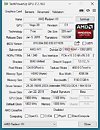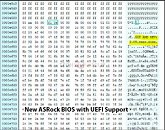- Joined
- Oct 9, 2007
- Messages
- 47,164 (7.57/day)
- Location
- Hyderabad, India
| System Name | RBMK-1000 |
|---|---|
| Processor | AMD Ryzen 7 5700G |
| Motherboard | ASUS ROG Strix B450-E Gaming |
| Cooling | DeepCool Gammax L240 V2 |
| Memory | 2x 8GB G.Skill Sniper X |
| Video Card(s) | Palit GeForce RTX 2080 SUPER GameRock |
| Storage | Western Digital Black NVMe 512GB |
| Display(s) | BenQ 1440p 60 Hz 27-inch |
| Case | Corsair Carbide 100R |
| Audio Device(s) | ASUS SupremeFX S1220A |
| Power Supply | Cooler Master MWE Gold 650W |
| Mouse | ASUS ROG Strix Impact |
| Keyboard | Gamdias Hermes E2 |
| Software | Windows 11 Pro |
In what is turning out to be a massive QA oversight by AMD, people who bought retail Radeon VII graphics cards report that their cards don't support UEFI, and that installing the card in their machines causes their motherboard to engage CSM (compatibility support module), a key component of UEFI firmware that's needed to boot the machine with UEFI-unaware hardware (such as old storage devices, graphics cards, NICs, etc.,).
To verify this claim, we put the stock video BIOS of our Radeon VII sample in a hex editor, and what we found out startled us. The BIOS completely lacks UEFI support, including a GOP (graphics output protocol) driver. A GOP driver is a wafer-thin display driver that runs basic display functions on your GPU during the pre-boot environment. Without UEFI support for the graphics card (i.e. with CSM running), Windows 10 cannot engage Secure Boot. Since UEFI Secure Boot is a requirement for Microsoft Windows 10 Logo certification, we are having doubts whether AMD can really claim "Windows 10 compatible" for Radeon VII, at least until a BIOS update is available.


ASRock is the first AMD AIB (add-in board partner) to release a corrective BIOS update. Although designed for its Radeon VII Phantom Gaming graphics card, this BIOS ROM works with any reference-design Radeon VII graphics card. All Radeon VII cards are identical, so flashing the ASRock BIOS onto a Radeon VII from AMD or any other board partner will not cause any issues.
Parsing the ASRock BIOS ROM file through a hex editor lets us see telltale signs of UEFI support, including the GOP micro-driver. Please pay attention to the highlighted UEFI-magic, which, when read in Intel byte-order, becomes "0EF1" aka "UEFI" in leetspeak. This magic sequence of bytes tells the rest of the system that the BIOS on this specific device reports that it supports the UEFI standard.
It is highly likely that most, if not all, Radeon VII graphics cards shipped so far lack UEFI support, and in the coming days, all AIB partners could come up with BIOS updates. Trouble is, updating video BIOS isn't anywhere near as easy as updating motherboard BIOS, and not everyone is skilled or confident enough to tinker with it. One option AMD could try is an encapsulated one-click BIOS updater that can run from within Windows.
Last year, NVIDIA corrected widespread DisplayPort issues in its "Pascal" graphics cards using such an approach. Until something like that happens, you can grab the updated Radeon VII Phantom Gaming video BIOS from the TechPowerUp VGA BIOS Database, linked below. The ATI/AMD BIOS flashing software can also be found in our downloads section.
DOWNLOAD: ASRock Radeon VII Phantom Gaming BIOS Update with UEFI Support
Update Feb 12: AMD has confirmed that they will release a one-click BIOS updater on AMD.com very soon, and that their board partners have received a UEFI capable BIOS.
View at TechPowerUp Main Site
To verify this claim, we put the stock video BIOS of our Radeon VII sample in a hex editor, and what we found out startled us. The BIOS completely lacks UEFI support, including a GOP (graphics output protocol) driver. A GOP driver is a wafer-thin display driver that runs basic display functions on your GPU during the pre-boot environment. Without UEFI support for the graphics card (i.e. with CSM running), Windows 10 cannot engage Secure Boot. Since UEFI Secure Boot is a requirement for Microsoft Windows 10 Logo certification, we are having doubts whether AMD can really claim "Windows 10 compatible" for Radeon VII, at least until a BIOS update is available.


ASRock is the first AMD AIB (add-in board partner) to release a corrective BIOS update. Although designed for its Radeon VII Phantom Gaming graphics card, this BIOS ROM works with any reference-design Radeon VII graphics card. All Radeon VII cards are identical, so flashing the ASRock BIOS onto a Radeon VII from AMD or any other board partner will not cause any issues.
Parsing the ASRock BIOS ROM file through a hex editor lets us see telltale signs of UEFI support, including the GOP micro-driver. Please pay attention to the highlighted UEFI-magic, which, when read in Intel byte-order, becomes "0EF1" aka "UEFI" in leetspeak. This magic sequence of bytes tells the rest of the system that the BIOS on this specific device reports that it supports the UEFI standard.
It is highly likely that most, if not all, Radeon VII graphics cards shipped so far lack UEFI support, and in the coming days, all AIB partners could come up with BIOS updates. Trouble is, updating video BIOS isn't anywhere near as easy as updating motherboard BIOS, and not everyone is skilled or confident enough to tinker with it. One option AMD could try is an encapsulated one-click BIOS updater that can run from within Windows.
Last year, NVIDIA corrected widespread DisplayPort issues in its "Pascal" graphics cards using such an approach. Until something like that happens, you can grab the updated Radeon VII Phantom Gaming video BIOS from the TechPowerUp VGA BIOS Database, linked below. The ATI/AMD BIOS flashing software can also be found in our downloads section.
DOWNLOAD: ASRock Radeon VII Phantom Gaming BIOS Update with UEFI Support
Update Feb 12: AMD has confirmed that they will release a one-click BIOS updater on AMD.com very soon, and that their board partners have received a UEFI capable BIOS.
View at TechPowerUp Main Site







